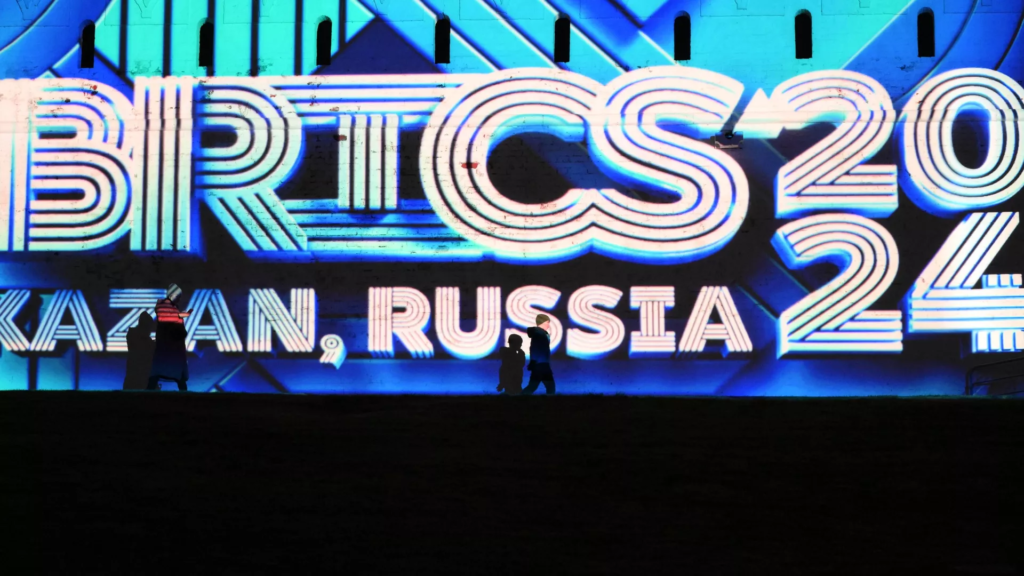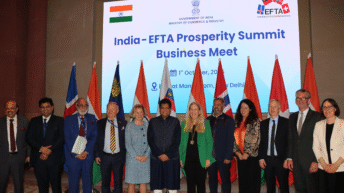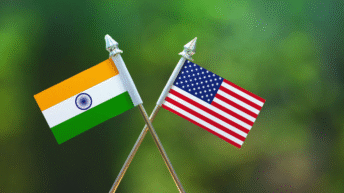
As Russia presides over the BRICS summit at Kazan from 22-24 October 2024, President Vladimir Putin has pledged to “strengthening multilateralism for equitable global development and security,” as an increasing number of countries wish to pursue their national interests and the interests of partner countries, and do not want to live under the US-enforced “rules-based order.”
BRICS, an acronym for Brazil-Russia-India-China-South Africa, has evolved into a “brand” and will retain this name despite the growing membership, according to what Russian Deputy Foreign Minister Sergey Ryabkov announced at the 2023 BRICS summit in Johannesburg, South Africa. Ethiopia, Saudi Arabia, Iran, Egypt, and the United Arab Emirates have been admitted in January 2024 and will attend the summit. Egypt’s entry has brought the Suez Canal into the BRICS family, signalling a major pivot in world history. President Putin’s special invitees include Serbia, Palestine, Mongolia and Armenia.
As many as 30 nations, including Venezuela, Thailand, Senegal, Cuba, Kazakhstan, Belarus, Bahrain, Pakistan, Mexico, Indonesia, Nigeria, Yemen, Vietnam and Azerbaijan are keen to join BRICS. To Washington’s dismay, Türkiye, which hosts the second largest NATO army, has expressed a desire to join, thereby confirming a shift towards a multipolar world order and the end of US dominance.
President Javier Milei, however, withdrew Argentina from the group, a move denounced by Venezuelan President Nicolás Maduro, “Javier Milei is taking Argentina back to the 19th century… take it out of the multipolar world, turn it into a vassal of the imperial unipolar world, and turn it into a new South American colony – destroy the State, destroy its economy, destroy its identity.”
BRICS vs G7
BRICS differs from the G7 (US, Japan, Germany, Italy, France, Britain, and Canada) as it is not based on a single political-economic ideology (neo-liberalism), but rests on mutual respect for different cultures and traditions, as Russian philosopher Alexander Dugin observed at the St. Petersburg International Economic Forum (June 5-8, 2024).
Western sanctions imposed after Russia’s special military operation in Ukraine in February 2022, compelled Moscow to diversify its economy while BRICS nations continued or enhanced their trade with Russia. BRICS is expected to surpass the GDP of the G-7. In 2023, the G-7 GDP stood at around 30 per cent of global GDP while that of BRICS reached 35 per cent.
Currently, the BRICS bloc commands a total investable wealth estimated at $45 trillion and is poised to wield influence in the global community, both economically and demographically. The millionaire population within these countries is predicted to rise by 85 per cent over the next decade, according to Dominic Volek, Group Head of Private Clients at Henley & Partners. As India and China on their own, comprise nearly 40 per cent of the world’s population, they command huge consumer markets and labour forces. The group is a fertile environment for investments across a broad spectrum, from technology and consumer goods to infrastructure development.
Major BRICS member nations like Russia, Saudi Arabia, UAE and Iran are rich in oil and natural gas. Iran, also punished by Western sanctions, has called for a ‘joint currency’ to sideline the US dollar. Some countries have already begun using local legal tenders for cross-border transactions. Oil-rich Nigeria has decided to sell oil in local currency and cryptos and aims to join BRICS.
By trading in national currencies and proposing to develop a BRICS virtual reserve currency, the alliance aims to dethrone the US dollar in global markets. Russia and China have taken the lead with their bilateral trade touching “$200 billion ahead of schedule,” according to Russian Prime Minister Mikhail Mishustin.
The New Development Bank (NDB), is preparing to offer ‘Maharaja Bonds’ worth $28 billion in global markets, for governments, financial institutions, and regular investors that can be purchased in local currencies. This is expected to strengthen local currencies and boost the respective national economies. Over the next five years, NDB plans to raise $3 billion in local tender to provide loans for developing countries’ infrastructure projects, which will be disbursed in the respective currencies.
Trade between Russia and Brazil surged to the equivalent of $1.6 billion in December 2023, despite Western sanctions, according to data from the Brazilian statistics service. Around $1.5 billion was spent for Brazil’s import of petroleum products from Russia. Brazil only recognises sanctions issued by the UN Security Council and has expanded trade with Moscow in commodities such as fertilisers ($300 million) and uranium ($10 million).
In early January 2024, the multinational investment bank Morgan Stanley downgraded the outlook for the US dollar from ‘Bullish’ to ‘Neutral,’ noting that the Federal Reserve interest rate cuts led to the decline of US Treasury yields. In December 2023, Goldman Sachs called the US dollar ‘Bearish’.
Oil Trade
Western sanctions have compelled Iran and Russia to direct oil sales to China, the world’s largest importer of crude oil. In 2023 alone, China saved around ten billion dollars by purchasing crude oil from Iran and Russia. The Beijing-Tehran oil trade bypasses Western banks and shipping services.
The alternative market of sanctioned oil is settled in Chinese RMB Yuan. The oil is carried by “dark fleet” tankers that operate without transponders to avoid detection and the Renmibi is used via small Chinese banks (such as the Bank of Kunlun) that limit the West’s access to financial transactions data and weaken their sanctions efforts. This helps China protect its large international banks from US sanctions.
When the oil shipments reach China, they are rebranded as Malaysian or Middle Eastern oil, and bought by “teapots” in China. These are small independent refineries that have absorbed 90 per cent of Iran’s total oil exports since the state-owned refiners stopped dealing with Iran due to the fear of sanctions.
Russia adopted Iran’s methods for exporting sanctioned oil after the G7 capped the price of Russian crude oil at US$ 60 per barrel in December 2022. Russia also uses a “shadow fleet” to ship oil to China and uses the renminbi for trade to circumvent the oil price cap.
Europe needs Russian oil despite the sanctions, so Moscow uses middlemen to launder crude oil sales to the West. A CERA report says that Russia has sold nearly US$ 2 billion worth of oil to Western countries in this manner. Most of the crude oil is sold to Turkey, which forwards it to the West. A Kpler analysis notes that India has funnelled large amounts of Russian oil to EU member-states.
In 2023, Saudi Arabia purchased Russian oil at discounted prices and laundered it across Europe. Should Turkey after Saudi Arabia join BRICS, the movement of Russian oil to Europe would become easier. The Gulf Cooperation Council (GCC) also helped Russia to secure oil deals bypassing US sanctions. The Middle East is open to accepting the Chinese yuan for oil transactions along with the US dollar. Ultimately, BRICS wants oil deals and trade in local currencies alone.
Minerals of the future
Russia has proposed the creation of an OPEC-like body to coordinate the production of solid minerals, specifically the ‘minerals of the future’ such as lithium, cobalt, and rare earth metals. These minerals are used in the production of high-tech products such as electric vehicles, hydrogen and wind and solar energy-generating equipment. Speaking at the Future Minerals Forum in Saudi Arabia, Alexander Kozlov, Minister of Natural Resources and Environment of the Russian Federation, suggested a deliberative platform involving Russia, African and Middle Eastern countries to coordinate activities in the mineral raw materials markets.
Kozlov said that Russia, Saudi Arabia, Iran, Iraq, Kuwait, Oman, Qatar, Syria, UAE, Yemen and Bahrain are leaders in the global energy sector and, with Russia, control 53 per cent of the world’s oil and 26 per cent of natural gas reserves. The changing geo-economic landscape calls for a joint technological policy for managing the ‘minerals of the future’.
Russia is a leading producer of some of these materials, viz., 27 per cent of the world’s production of platinum group metals, controls 22 per cent of world reserves of nickel, 13 per cent of cobalt, 15 per cent of titanium, 12 per cent of tungsten, 9 per cent of copper, 4 per cent of rare earths and graphite. Kozlov mooted the creation of long processing chains till the release of final products and offered to share experience. He said Russia is ready for mineral exploration and production, and for bilateral technology transfer. A plant to produce battery cells from mined lithium is being built in Kaliningrad by Renera, a subsidiary of Rosatom, with production scheduled to begin in August 2025, initially with imported raw materials.
Financial Messaging System
Russia and Iran were disconnected from the SWIFT network as part of Western sanctions. In January 2024, Russia and Iran moved towards a direct interbank transfer mechanism, so that the West could no longer control, block or disrupt their financial transactions. Mohsen Karimi, deputy head of the Central Bank of Iran, told Iranian state television that the system allows companies in both countries to trade in their respective national currencies instead of using the dollar or euro.
Russia is proposing its Financial Messaging System as an alternative to SWIFT with BRICS member-states, so that payments can be made in national currencies. Currently 159 foreign participants from 20 countries have joined the Russian platform, Russian Central Bank Head Elvira Nabiullina told Sputnik. She said cross-border settlements in digital currencies are on the anvil with BRICS and other friendly countries.
Illustrating the fact that non-dollar settlements are on the increase around the world, the UAE paid China Dh 500 million ($136 million) with a new Digital Dirham, via the ‘M Bridge’ payment platform.
The forthcoming BRICS summit plans to build a ‘Credit Rating Agency’ to counter Moody’s, Standard and Poor’s (S&P), and the Fitch Group’s domination of the global market and power to make or break a company’s prospects with their reports. Russia’s Central Bank Governor Nabiullina said that the BRICS rating agency will be “supranational” and cover all countries. It will launch a new internet service not connected to US data and servers.
Russia’s trade with China and India is already 95 per cent in national currencies, according to Tatiana Monaghan, secretary general of the International Chamber of Commerce (ICC). The share of the US Dollar and Euro in Russia’s export settlements has fallen from 85.6 per cent in January-December 2021 to 34.1 per cent in January-May 2023.
Eventually, BRICS plans an independent payment system based on digital currencies and blockchain, Kremlin aide Yury Ushakov told TASS. This would be convenient for governments, common people and businesses, besides being cost-effective and free of politics.
Ushakov said the aim is to enhance the role of BRICS in the international monetary and financial system. The 2023 Johannesburg Declaration urged leaders to increase settlements in national currencies and strengthen banking networks to secure international transactions. The group will develop a Contingent Reserve Arrangement for currencies other than the US dollar.
Grain Exchange
Russia has proposed that member countries create a BRICS grain exchange to ensure global food security. BRICS nations comprise nearly 30 per cent of the world’s arable land and jointly produce around 40 per cent of grain crops, 50 per cent of fish, and 50 per cent of dairy products worldwide.
BRICS Parliament
Long-term plans include a BRICS Parliament, an idea mooted by President Putin, to strengthen the group’s influence in world politics and perhaps even counter-sanction the West as a united bloc if the West imposes sanctions.
Iran has urged the creation of a formal security framework in the group. Currently BRICS members share views on security issues and the last BRICS Security Meeting was held in St. Petersburg on September 11, 2024.
Financial Crisis
JP Morgan CEO and leading US investment banker, Jamie Dimon, warns of a potential US economic crisis as the BRICS bloc grows increasingly relevant. Speaking at the Council of Institutional Investors in New York, Dimon cautioned that something far worse than a recession was looming.
On September 18, 2024, the US Federal Reserve cut interest rates for the first time in four years as inflation began receding towards its 2 per cent target. However, this did not help the nation’s fragile economy. Dimon said he would not rule out stagflation hitting the United States. “I would say the worst outcome is stagflation—recession, higher inflation.” Specific problems also include even higher deficits and constantly increased, out-of-control spending.
References:
1] https://twitter.com/amborin/status/1741859309213114712?t=5O9TQtoAkfy8z_Wgi4Z71Q&s=03
2] Moscow explains why expanded BRICS will keep name, RT, March 14, 2024
https://www.rt.com/business/594255-expanded-brics-will-keep-name
3] https://twitter.com/upholdreality/status/1741957346971062601?t=H6EQDxreMhFWe9eoqMQi3Q&s=03
4] BRICS total investable wealth reaches $45 trillion, Asian Business Review, March 20, 2024.
https://asianbusinessreview.com/videos/brics-total-investable-wealth-reaches-45-trillion
5] BRICS: Morgan Stanley Downgrades The U.S. Dollar, Watcher.Guru, January 5, 2024
6] BRICS to Eliminate US Dollar Financial System in 2024, watcher.guru, January 6, 2024.
7] BRICS Offers Bonds Worth $28 Billion in Local Currency, Ditching US Dollar, Watcher.Guru, January 12, 2024.
8] Russia boosting trade with fellow BRICS nation, RT, January 13, 2024.
https://www.rt.com/business/590386-russia-brazil-trade-soaring
9] BRICS: Morgan Stanley Downgrades The U.S. Dollar, Watcher.Guru, January 5, 2024
10] The axis of evasion: Behind China’s oil trade with Iran and Russia, New Atlanticist, March 28, 2024.
11] BRICS: Russia Sells $2 Billion Worth of Oil To the West Despite Sanctions, Watcher.Guru, Vinod Dsouza, September 21, 2024. https://watcher.guru/news/brics-russia-sells-2-billion-worth-of-oil-to-the-west-despite-sanctions#google_vignette
12] Russia proposes creating a global alliance of “raw materials of the future” producers, SCOBRICS Insight, January 11, 2024.
13] Russia and Iran don’t need SWIFT – Tehran, RT, January 8, 2024.
https://www.rt.com/business/590267-russia-iran-ditch-swift
14] Russia Discussing Integration of Payment Infrastructure With BRICS, Sputnik International, January 30, 2024.
15] BRICS: UAE Pays China With New Digital Dirham, Ditches US Dollar, Watcher.Guru, January 30, 2024.
16] BRICS To Build ‘Credit Rating Agency’ to Counter US Dominance, Watcher.Guru, Vinod Dsouza, February 3, 2024.
17] Russia’s trade with key BRICS partners now almost dollar-free, RT, February 12, 2024.
https://www.rt.com/business/592313-national-currencies-russia-india-china
18] Kremlin announces creation of blockchain-based payment system in BRICS, TASS, March 5, 2024.
https://tass.com/politics/1755521
19] https://x.com/BRICSinfo/status/1807147775529992620
20] JPMorgan CEO Warns of US Economic Crisis as BRICS Power Grows, Watcher.Guru, Joshua Ramos. September 19, 2024






Add comment